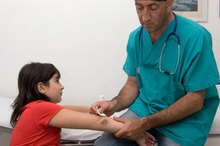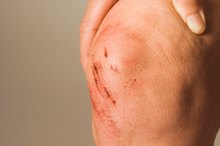Flying With a Broken Clavicle
Acting as strut connecting the sternum to the shoulder blade, the clavicle bone, or collarbone, is one of the most common bones subject to fracture. John Hopkins Sports Medicine notes that clavicle breaks typically occur when force is transferred to the bone as a result of a fall on an extended arm, or a severe blow to the shoulder 1. Five to 10 percent of all fractures occur to the collarbone. Men under 25 years of age are in the most susceptible group, especially when playing contact sports such as football and hockey, and competing in extreme sports such as cycling and motor-cross.
Symptoms
To be certain whether or not you have a broken clavicle involves seeing a doctor right away, who will get an x-ray to evaluate. Dr. Jason Wilcox, an orthopedic surgeon at Orthopedic Physician Associates in Seattle, specializes in sports medicine and arthroscopy. His descriptions of a broken clavicle include the initial symptoms of pain and shoulder immobilization. “Pain and deformity at the site of the fracture are the most common, with bruising to follow,” he says. “On occasion, there can be a tenting where one of the fragments is placing pressure on the skin, or worse yet, an actual wound where a fragment has punctured the skin.”
- To be certain whether or not you have a broken clavicle involves seeing a doctor right away, who will get an x-ray to evaluate.
- Pain and deformity at the site of the fracture are the most common, with bruising to follow,” he says.
- “
Considerations When Flying
A Splint for a Humerus Fracture
Learn More
Sometimes a sports injury occurs when athletes are on the road, and a physician determines it is best for the patient to fly home with the team. When flying, Dr. Wilcox sees comfort as the biggest variable with a broken clavicle. “At this early phase, even subtle movements would be painful, much less being bumped by a fellow passenger,” he states. Your doctor may have you wear a regular arm sling or figure-eight wrap for arm position and comfort immediately after the break and when flying. A prescription of NSAIDS, which are nonsteroidal anti-inflammatory drugs, also may be administered by your health professional to further relieve pain and reduce swelling prior to your flight. Arrive as early as possible at the airport and check your luggage so you won't have to tote it around. Tell the gate attendant in advance to request early boarding. Seat assignment is important. For instance, for a right clavicle fracture, sitting in the aircraft's right window seat would best protect the injury from being bumped by another passenger. If you have access to a pillow, use it to help find your best comfort position.
- Sometimes a sports injury occurs when athletes are on the road, and a physician determines it is best for the patient to fly home with the team.
- A prescription of NSAIDS, which are nonsteroidal anti-inflammatory drugs, also may be administered by your health professional to further relieve pain and reduce swelling prior to your flight.
Treatment
Broken clavicle bones hardly present an easy case for setting. If not severely shattered or with open wounds, broken collarbones are doctored and heal without surgery. Dr. Wilcox comments that some treatments can be controversial, but with more serious clavicle fractures, bones are being treated with some type of fixation -- either with plates and screws, or with other supporting devices. He recalls that “historically, surgery brought about complications, but more recent data suggests that wound complications are rarer now.”
- Broken clavicle bones hardly present an easy case for setting.
- Dr. Wilcox comments that some treatments can be controversial, but with more serious clavicle fractures, bones are being treated with some type of fixation -- either with plates and screws, or with other supporting devices.
Recovery
Symptoms of a Broken Sternum
Learn More
Range of motion exercises suggested by your doctor may have begun a week or two after the injury, followed by the doctor’s clearance to remove your sling after complete healing. Specific exercises or physical therapy might follow to restore flexibility and muscle atrophy. Broken bones in adults heal in six to 12 weeks, and Dr. Wilcox asserts that there may be variables along the way. “Recovery is based upon the patient’s pain and evidence of healing as seen on serial x-rays,” he says. “Once fragments have begun to heal, they are more stable, and flying would certainly be more comfortable.”
- Range of motion exercises suggested by your doctor may have begun a week or two after the injury, followed by the doctor’s clearance to remove your sling after complete healing.
Related Articles
References
- Johns Hopkins: Sports Medicine Patient Guide to Clavicle (Collarbone) Fracture
- American Family Physician: Clavicle Fractures
- sportsmd: Broken Collar Bone
- Paladini P, Pellegrini A, Merolla G, Campi F, Porcellini G. Treatment of clavicle fractures. Transl Med UniSa. 2012;2:47-58.
- Mckee RC, Whelan DB, Schemitsch EH, Mckee MD. Operative versus nonoperative care of displaced midshaft clavicular fractures: a meta-analysis of randomized clinical trials. J Bone Joint Surg Am. 2012;94(8):675-84. doi:10.2106/JBJS.J.01364
- Mills LA, Aitken SA, Simpson AHRW. The risk of non-union per fracture: current myths and revised figures from a population of over 4 million adults. Acta Orthop. 2017;88(4):434-439. doi:10.1080/17453674.2017.1321351
- Murray IR, Foster CJ, Eros A, Robinson CM. Risk factors for nonunion after nonoperative treatment of displaced midshaft fractures of the clavicle. J Bone Joint Surg Am. 2013;95(13):1153-8. doi:10.2106/JBJS.K.01275
- Liu PC, Hsieh CH, Chen JC, Lu CC, Chuo CY, Chien SH. Infection after surgical reconstruction of a clavicle fracture using a reconstruction plate: a report of seven cases. Kaohsiung J Med Sci. 2008;24(1):45-9. doi:10.1016/S1607-551X(08)70073-1
- Ou L, Yang L, Zhao J, Su W. Cutaneous paresthesia after internal plate fixation of clavicle fractures and underlying anatomical observations. Medicine (Baltimore). 2018;97(41):e12729. doi:10.1097/MD.0000000000012729
- McKee RC, Whelan DB, Schemitsch EH, McKee MD: Operative versus nonoperative care of displaced midshaft clavicular fractures: A meta-analysis of randomized clinical trials. J Bone Joint Surg Am 2012;94:675–684. doi:10.2106/JBJS.J.01364.
Writer Bio
Edward Winkle got his start as a content writer and website manager for Guest Informant, a publisher of city guides. He continues to embrace topics on travel, real estate, health and nutrition. He graduated from Washington State University and lives in the Seattle area with his wife.









